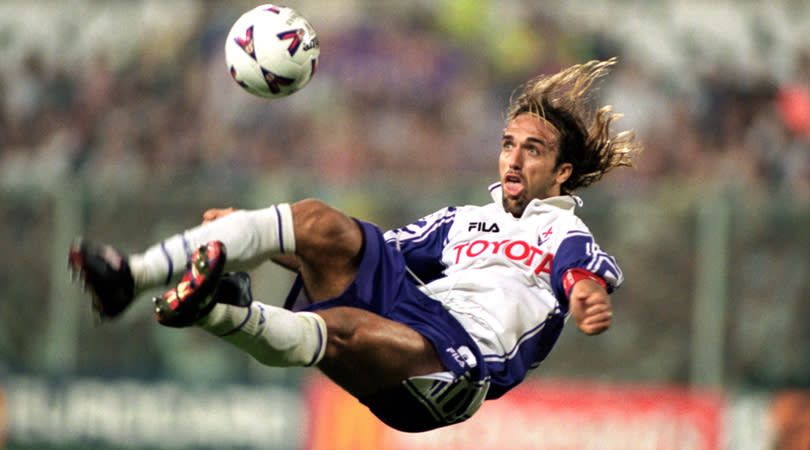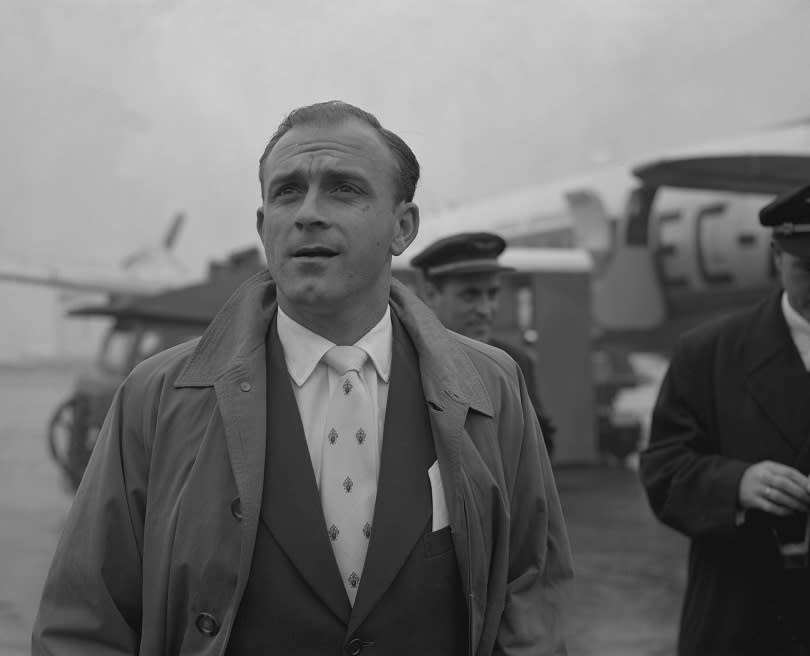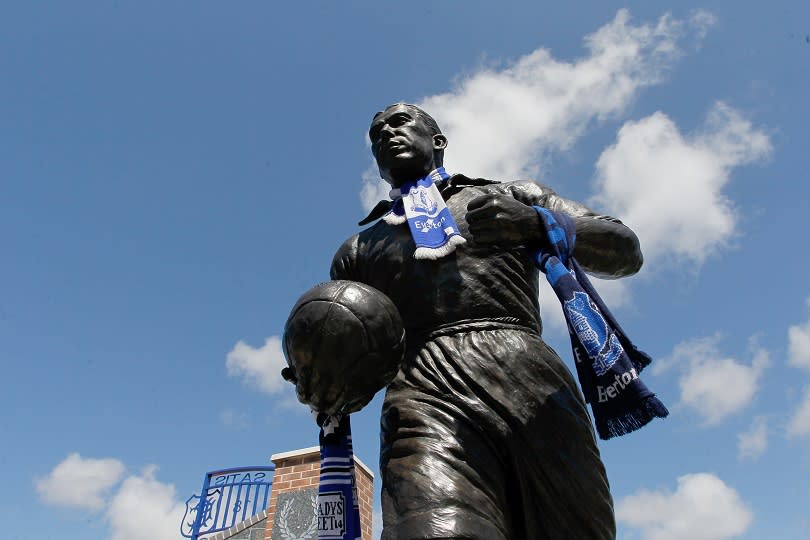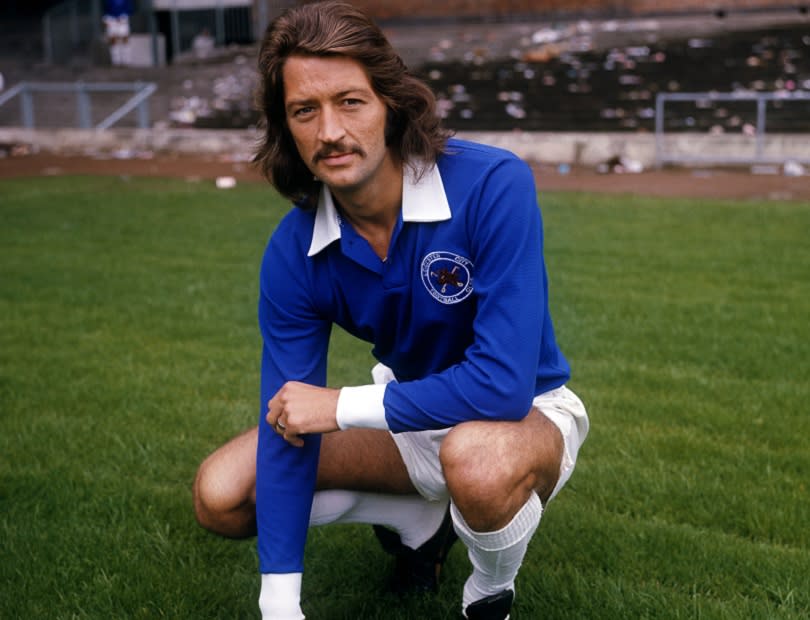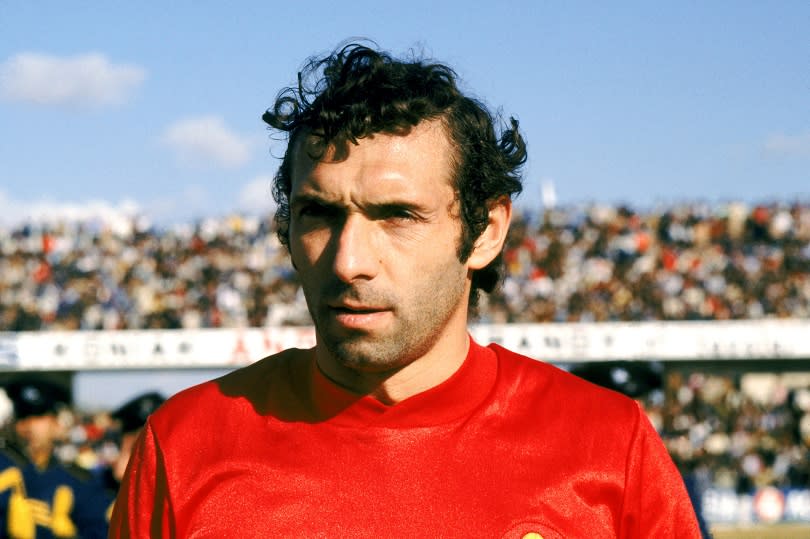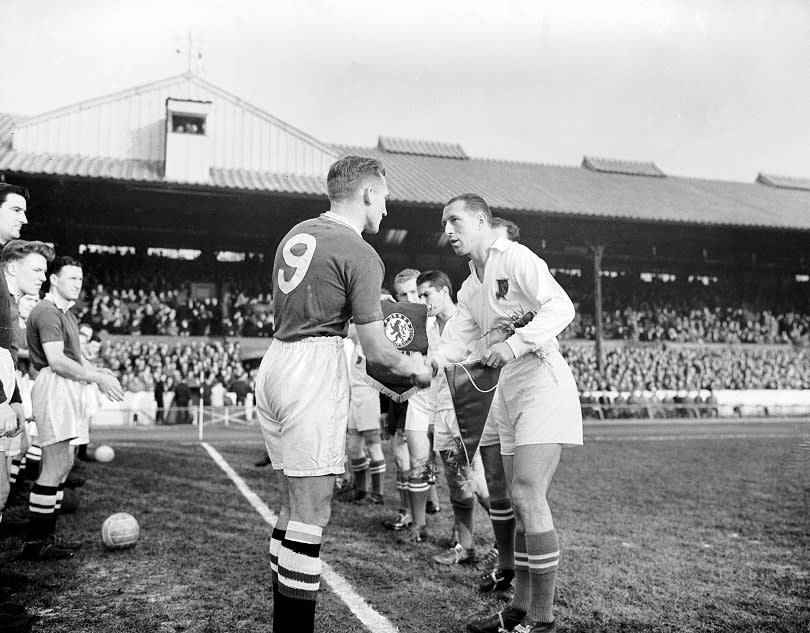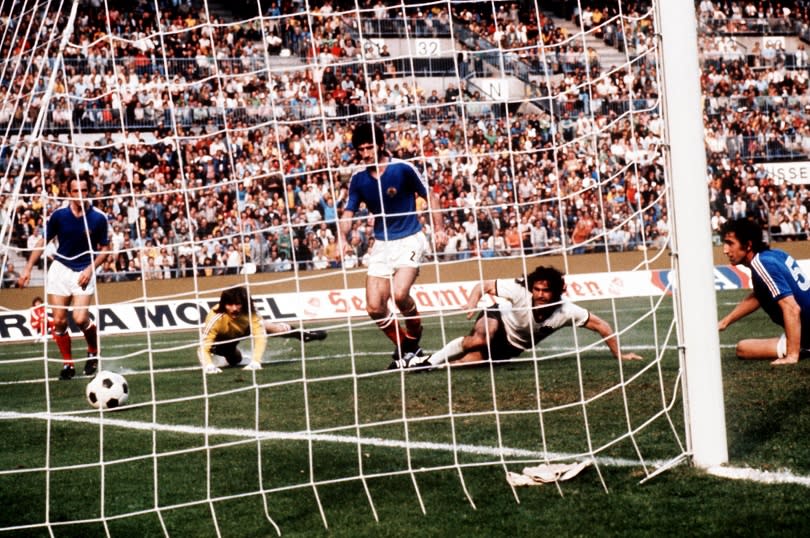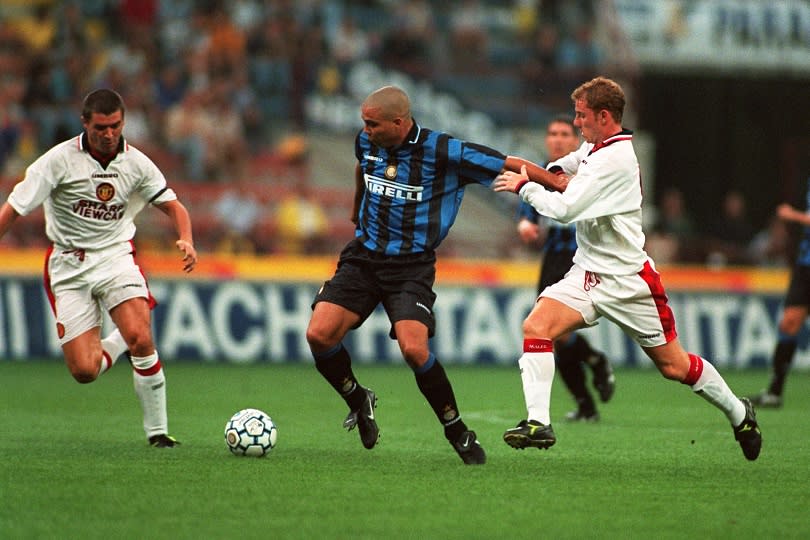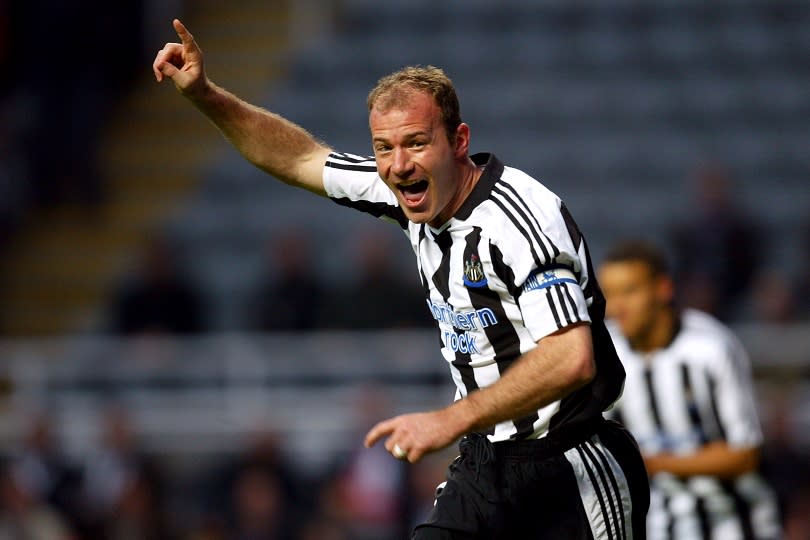13 of footballs greatest-ever No.9s – and the brilliant stories behind them
1. The shiny foreigner: Alfredo Di Stefano
Matches: 709, Goals: 519
So good, he was at the centre of a row between the two outstanding players of last century. “I really don’t know if I was better than Pele,” said Diego Maradona. “But Di Stefano was.” The Brazilian hit back by claiming that Di Stefano was also superior to Diego. Petty point-scoring aside, it's evident that the man in question was a ruthlessly efficient No.9.
Dubbed ‘the Blond Arrow’ for his direct, incisive play, the Argentine-Spanish schemer married graft (“I always saw football as a game in which you must run and sweat”) with a tactical awareness ahead of his time: he was pivotal in Real Madrid’s ascendancy, playing (and scoring) in all five of their 1950s European Cup wins, while his bustling on-pitch movement helped inspire modern tactics.
He was far from a pure No.9. He scored loads (307 in 396 official games for Real), but Di Stefano was also a manager’s dream: he could defend stoutly, put chances on a plate and connect play in midfield with his calm passing. His style was perhaps most similar to a famous No.10, Zinedine Zidane.
“The greatness of Alfredo is that, with him in your side, you have two players in every position,” said Madrid coach Miguel Minoz. Having Ferenc Puskas and Raymond Kopa alongside helped, too.
His nationality was also of great interest. La Liga may now be dripping with Latin talent, but Di Stefano was a trailblazer. Born in Buenos Aires, he was the first great import from South America. Arriving from Millonairos of Colombia in 1953, his appetite for the big games – he remains the second-highest scorer in El Clasico – meant he was rapidly welcomed. He felt right at home, too, eventually taking Spanish nationality and starring for the national side.
2. The original No.9: Dixie Dean
Matches: 505, Goals: 443
“Dixie Dean belongs to the company of the supremely great – like Beethoven, Shakespeare and Rembrandt,” reckoned Bill Shankly. The Liverpool boss was given to hyperbole, but he wasn’t normally one for praising Evertonians, so his assessment of the first man ever to wear No.9 for the Blues speaks volumes.
Dixie – known as William to his mum – was the greatest English club goalscorer of all time. His stats are remarkable: 425 goals in 489 club appearances (a better net-busting ratio than Gerd Muller) and a ludicrous 60 league goals in one season (1927/28), where as an unstoppable 21-year-old he led Everton to the title.
But how did the Birkenhead-born lad do it? He was competent enough with his feet, but in the air he was a genius. Despite being just 5ft 10in, Dean was an aerial bully: in an age of long punts, multiple crosses and dogged defenders, he had the knack of toppling his opponents like skittles and planting his head on the ball. Never booked or sent off, he wasn’t above comparing himself to Jesus, either. “People ask me if that 60-goal record will ever be beaten,” he said. “I think it will. But there’s only one man who’ll do it – the fellow that walks on the water.”
Cocky, sure, but he’s probably right – even Lionel Messi's only ever managed 50.
3. The womaniser: Frank Worthington
Matches: 836, Goals: 262
Yorkshire’s own George Best, in more ways than one. The famous duo shared socks-round-the-ankles on-pitch stylings, a ‘weakness’ for dating models and utterly sublime skills that should have seen them achieve far more than they did.
Worthington was an outstandingly gifted No.9; his vision and verve shone out in the late ’60s and early ’70s of grey old England. He was far better than the largely honest workhorses that played for Huddersfield and Leicester – his first two clubs, and the only ones where he enjoyed real stability – and he didn’t half know it. “Other players control the ball further than I kick it,” he mocked, before confessing: “The way I played is more important than the team winning.”
Alas, Worthington was his own worst enemy: called up for the Three Lions, Frank enraged manager Alf Ramsey by arriving in high-heeled cowboy boots; Bill Shankly tried to sign him for Liverpool, but he failed the medical (“I was enjoying the fruits of being young”). His antics – vividly described in his autobiography, One Hump Or Two? – included cheating on Miss Great Britain by having a threesome with a Swedish mother and daughter, and partying in the Caribbean with Omar Sharif.
He was transferred 22 times over a 15-year period from 1977 and won nothing of note, but the talent never left him (visit YouTube to see his ludicrous strike for Bolton against Ipswich), and from Stockport to Galway, Philadelphia to Mjallby, the Elvis-haired nomad was always a goal-grabbing fan favourite. If he’d been an early-to-bed Michael Owen type, he’d have got 80 England caps rather than eight. But then he wouldn’t have been Frank Worthington…
Worthington's stunning strike against Ipswich
4. The acrobat: Hugo Sanchez
Mexican. Matches: 881 Goals: 516
There’s an utterly ridiculous stat that tells you all you need to know about Hugo Sanchez. In 1989/90, en route to his fifth La Liga Pichichi (Golden Boot) in six years, he scored 38 goals – from 38 touches. The curly-haired Mexican maestro’s instinct was so sharp that he didn’t need to go in for anything as mundane as controlling the ball: he simply applied the necessary to guide it into the net.
Because this included life-threatening diving headers, impossibly swerving free-kicks and numerous windmilling bicycle kicks – all underpinned by his training as a gymnast, and celebrated with an athletic somersault – he is remembered by some as something of a circus act. This is deeply unfair: Sanchez (right) scored plenty of poacher’s efforts – and the quantity matched the quality, too. Having made his name in Mexico with UNAM, he became a legend at both of Madrid’s biggest clubs, first guiding Atletico to a Copa del Rey, then grabbing five titles with Real.
His 234 La Liga glut was only surpassed by Lionel Messi – and Sanchez scored dazzlers just as breathtaking as the Argentine's. As his coach Leo Beenhakker once said after a typical ‘Hugol’ overhead effort: “When a player scores like that, play should be suspended and a glass of champagne offered to the fans.”
FEATURE Who the hell is Hugo Sanchez?
5. The hostage: Quini
Matches: 721, Goals: 377
As any dutiful partner being dragged around the shops on a Saturday afternoon knows, being kidnapped is no fun. Yet it wasn’t retail therapy that was on the minds of Barcelona striker Quini’s captors in March 1981.
Bundled into a van by two unemployed mechanics and a debt-ridden electrician after scoring twice in a 6-0 destruction of Hercules, the Barça No.9’s 25-day incarceration had Spain gripped amid the backdrop of a failed political coup and regular bombings by Basque terrorist group ETA. The kidnappers demanded £1.8m to release their new ‘friend’.
Quini’s team-mate Bernd Schuster initially refused to play until the striker’s release. “Apart from legs, I’ve got a heart,” wailed the German midfielder, “I just want Quini back.”
La Liga’s eighth-most-prolific marksman was eventually freed (no ransom was paid) from the Zaragoza car park where he'd spent the majority of his captivity. Despite Quini not pressing charges (“They treated me well and asked me all the time to be calm, assuring me nothing would happen,” he said upon release), his clueless captors were each sentenced to 10 years in prison.
Barça’s title hopes collapsed – they won just one point from the four games Quini missed – and they finished the season in fifth place. Remarkably, despite his ordeal, Quini still won that season’s Pichichi as La Liga’s top scorer.
6. The unlikely hero: Gabriel Batistuta
Matches: 554, Goals: 353
Argentines tend to adore their fantasista No.10s over the more straightforward goal-getters in the No.9 shirt: think Mario Kempes, Ariel Ortega, Juan Roman Riquelme – and, of course, Diego and Lionel. These are mentally quick wizards who can conjure and scheme despite not having the greatest physical gifts, a quality prized by many in Argentina over the ability to blast a lace through leather. But there was no way they couldn't love Gabriel Batistuta.
He came out the blocks quickly when first picked for the national side, finishing top scorer in the 1991 Copa America as Argentina stormed to victory. The forward had an all-round game: he was fast and clinical like all good No.9s, but could also hit great free-kicks, win aerial duels and link play cleverly – especially with Maradona.
He was admirably loyal, too, sticking with Fiorentina even after they got relegated. Batigol finished his career 11th in the Serie A all-time list (184 goals) and as Argentina’s top international marksman, with 56 in 78.
Batistuta scores against Arsenal
7. The export: John Charles
Matches: 721, Goals: 348
Charles is on an extremely short list of players who were genuinely world-class in two completely different positions (Philipp Lahm, perhaps, also has a shout): a 6ft 2in Welsh powerhouse who spent his first three seasons at Leeds as a commanding, skilful and considered centre-back, he could undoubtedly have gone on to become one of the greatest defenders of his generation. Instead, he was switched to play up front in October 1952 amid a centre-forward injury crisis – and his career as one of the world’s finest No.9s began.
Charles was a reverse Dixie Dean: whereas Dean was a small man who was decent on the deck but incredible in the air, Charles was a serious unit and brilliant header of the ball who was somehow even better with his feet. He was fast, technical, smart and became Leeds’s second-highest all-time scorer.
He was also Britain’s greatest-ever export – one of very few to ever become legendary with an overseas club. Joining Juventus in 1957 after snubbing Manchester United and Arsenal, he scored 93 goals as they won the Scudetto three times. They still rate him as their best-ever foreign player. If they could have cloned him, Wales might have won a World Cup…
8. The goal hanger: Pippo Inzaghi
Matches: 680, Goals: 313
Such was Inzaghi’s knack for giving the linesman’s arm a good workout, Sir Alex Ferguson once speculated that the Italian “must have been born offside”.
‘Super Pippo’ did indeed regularly stray – every 42 minutes during Milan’s successful Champions League campaign of 2006/07 – but with Juventus and the Rossoneri, he also always ended up in the right place at the right time to snaffle an ‘easy’ goal. It was no coincidence.
“Inzaghi used to study videos of opponents for days on end,” said his Milan team-mate Gennaro Gattuso. “Many thought Pippo was lucky, but it was nothing to do with luck – it was down to skill and preparation.”
His finest hour came in May 2007, when his two goals helped Milan win the Champions League final against Liverpool. The first came from an Andrea Pirlo free-kick which deflected in off Inzaghi’s shoulder. With most strikers you’d say “he didn’t know much about it”, but with Pippo you can never be sure.
Try telling Inzaghi he didn't mean it...
9. The false nine: Nandor Hidegkuti
Matches: 450, Goals: 304
You might think that Barcelona and Pep Guardiola invented the deep-lying centre-forward. Think again. It first blossomed through a frail Hungarian who started out as a winger.
One of the few players not co-opted by Honved, the Hungarian army’s team, Hidegkuti is best remembered for his two spells at secret-police-funded MTK and the national team under Gusztav Sebes. Sebes didn’t have a battering ram striker to win headers, so went for something more nuanced. “The idea emerged to play the No.9 deeper where there was space,” said Hidegkuti.
Against England in November 1953, the Hungarian gave a recital, drifting away from Blackpool centre-half Harry Johnston to have the freedom of the Wembley pitch. Hidegkuti scored a hat-trick in a 6-3 win, the Three Lions’ first defeat to foreign opposition on home soil.
“We used to joke with our defenders sometimes: ‘Don’t worry if you let one in, we’ll score two’,” Hidegkuti later chuckled. Ferenc Puskas may have been Hungary’s star, but without the efforts of his deep-lying No.9, he wouldn't have had the space to succeed.
10. The poacher: Gerd Muller
Matches: 769, Goals: 721
There are plenty of misconceptions about the Germany and Bayern Munich goal machine Gerd Muller. One is that he was athletically average. Cursed with the nickname ‘Kleines dickes Muller’ – short, fat Muller – thanks to his somewhat squat stature, he was never going to be a CR7-style slice of muscle that could bulldoze defences. But he had a devastating turn of speed over short distances. “His pace was incredible,” reckoned Franz Beckenbauer. “In training, I never had a chance.”
Another is that his tendency for unglamorous tap-ins – hundreds of ’em – somehow lessened his worth compared to a Neymar-style box of tricks. In fact, Muller scored plenty of strikes that were extremely hard to execute.
His control and ability to turn in tight spaces were second to none, but what makes him arguably the purest No.9 in history was the sheer unpredictability of his close-range finishing. Play him the same pass 10 times, and the ball will usually end up in the net – but always in a different place. It may not be spectacular, but this metronomic ability to deceive the goalkeeper was unique: if scoring easy-looking goals was truly easy, then why couldn’t anyone else do it in Muller-like volumes?
His stat reel is mind-blowing: 566 Bayern Munich goals in 607 games; 68 in 62 for West Germany; 85 in the calendar year of 1972. And he did it when it really counted, too: at the 1970 World Cup (10 goals), at the 1972 European Championship (top scorer, two goals in the final) and at the 1974 World Cup, where he slotted the winner at his home stadium and outshone Johan Cruyff. How did he do it? Even he wasn’t sure. “You can’t learn it,” he stated. “You’ve got to have an instinct.” His was God-given.
11. The force of nature: Ronaldo
Matches: 616, Goals: 414
Let’s get one thing clear: anyone who refers to El Fenomeno as ‘Fat Ronaldo’ needs hurling in a dank prison cell for all eternity. Sure, the boy Cristiano has carved out a half-decent career for himself, but his Brazilian namesake – regardless of the size of his waistline during the latter stages of his career – is the Ronaldo.
Be it in the Netherlands (54 goals in 57 matches), Spain (151 in 226), Italy (68 in 119) or back home in Brazil (79 in 116), wherever he played he scored goals like it was the easiest thing in the world. To him it probably was. Combining searing pace, gargantuan strength and ruthless instincts, Ronaldo was the model striker. He put the fear of God into opposition defenders – they knew there was very little they could do to stop him.
His goal for Barcelona at Compostela in 1996/97, arguably his finest season, summed him up perfectly. Lurking inside his own half, the Brazilian outmuscled one Compostela player, holding him off as he yanked at his arm, before dazzling a covering defender with a drag-back, then clicking through the gears to burn past another. As he approached the edge of the opposition box, Ronaldo cut inside, bamboozling another two of his by-now-panting foes with a quick stepover, before sliding a low shot into the bottom corner. His manager, the great Bobby Robson, was visibly stunned. It was probably at that moment that he realised his No.9 was a force of nature.
It was poetic that Ronaldo should be the man to win the World Cup for Brazil in 2002, after the trauma suffered in France four years earlier. His Wikipedia page should without doubt be the first result when you Google ‘Ronaldo’. You can shove ‘search engine optimisation’ up your backside.
Ronaldo's goal against Compostela
12. The record breaker: Alan Shearer
Matches: 797, Goals: 409
Younger readers shouldn’t be fooled by his dad jokes (and chunky knitwear) on the Match of the Day sofa – Alan Shearer was as deadly as any striker world football has seen in the modern era. Throughout the ’90s, he was the man every English schoolboy pretended to be on the playground.
Having been rejected by his hometown club Newcastle, he headed to the other end of the country in search of a shot at the big time. A debut hat-trick for Southampton against Arsenal put the 17-year-old Shearer on the map, and by the time he’d netted 21 goals in the 1991/92 season, he was undoubtedly English football’s brightest young thing.
A big money move to Blackburn – yes, Blackburn – quickly followed. There he scored 112 Premier League goals in 138 matches, during which time he helped Rovers to the Premier League title and secured his status as England’s regular No.9.
But it wasn’t all plain sailing. In the run-up to Euro 96, Shearer was on a run of 12 matches without an international goal – a barren run spanning almost two years. That came to a dramatic end at the tournament, where Shearer’s five goals helped England to the semi-finals and meant he was once again in great demand. The emotional pull of a return home saw Shearer spurn champions Manchester United in favour of a return to Newcastle, where, unburdened by a world-record £15m fee, the goals continued to flow.
A rugged monster of a striker who seemed bigger than his 6ft frame, Shearer was consistent, fearless and consistently ruthless. Over the course of his career, he surpassed the 20-goal mark in 11 seasons, breaching 30 on four occasions.
Regrets? Well, not winning a trophy between that Premier League title in 1995 and retiring in 2006 will rank pretty highly, but a decade playing for his boyhood heroes and cementing himself as a Geordie legend will certainly help ease the pain.
13. The battering ram: Nat Lofthouse
Matches: 485, Goals: 285
“In my day, there were plenty of fellas who would kick your bollocks off,” said Nat Lofthouse. “The difference was that at the end of the match they’d shake your hand and help you look for them.”
His comment was more than just a good line. The blood and thunder of Lofthouse’s era – he made his debut shortly after WWII – was very real. His hardy generation (Lofthouse was conscripted to work in the mines) didn’t shy away from a battle, and the Boltonian, who played at his hometown club for his entire career, was a maestro amid the heavy balls and bad pitches of his era.
Lofthouse was of average height but did his best work in the air, having honed his heading skills with a tennis ball. His most celebrated moments both involved him taking a bruising: in May 1952 he earned his ‘Lion of Vienna’ tag, scoring against Austria for England despite being elbowed in the face, hacked at from behind and felled by the goalkeeper. Six years later, as the captain of Bolton in the FA Cup final against Manchester United, he turned the tables, shoulder-charging keeper Harry Gregg into his own net to score the second of two goals and lift the trophy. Nat later admitted it should have been a foul.
There was much to admire beyond the warrior, though. Lofthouse had a great shot, a mazy dribble, was tactically astute and was a true leader, bagging 255 goals for his club and 30 for England from 33 caps. He remains worshipped in Bolton, where he later became a club scout, chief coach, manager and life president before his death in January 2011.
This feature originally appeared in the December 2015 issue of FourFourTwo. Subscribe!

 Yahoo Sport
Yahoo Sport 






































